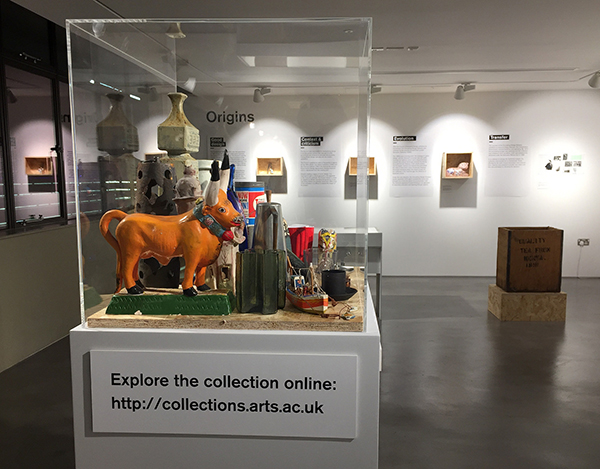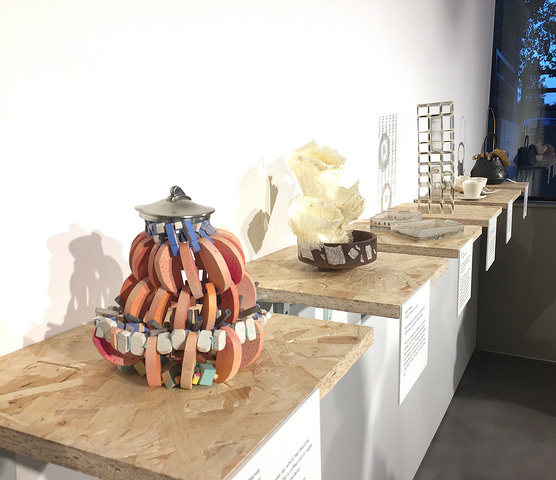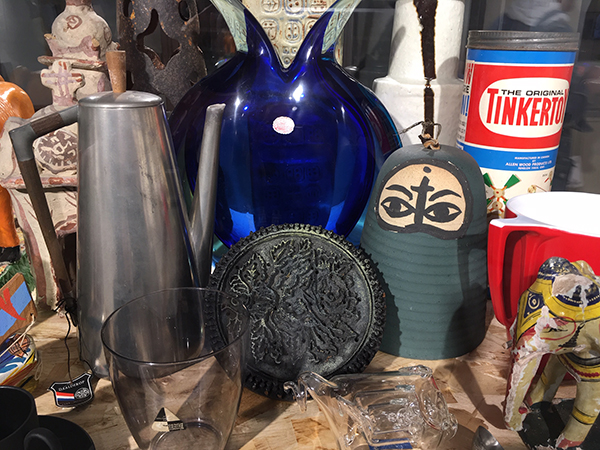by E Okobi (MSc Applied Psychology in Fashion, LCF)
reporting back from Post-Grad Pop Up Common Room: A Narrative of Progress at Camberwell Space
On 23 October, members of the UAL Post-Grad Community visited ‘A Narrative of Progress’ in its final week at Camberwell Space, the public gallery housed at the UAL Camberwell campus. The objects in the exhibition were selected from the Camberwell ILEA Collection—including some deaccessioned objects which had been reimagined by students on the Camberwell MA Designer Maker programme. Post-Grad Community visitors were treated to a joint talk from Martin Williams, alumni of the MA Designer Maker programme at Camberwell and contributor of a reimagined object featured in the show, the talk was also given by Daisy McMullan, Camberwell Space Gallery Coordinator.
 The Camberwell ILEA collection was initiated in 1951 as a joint endeavour of the Council of Industrial Design and the London County Council to teach schoolchildren the precepts of good design through experiential, object-based learning. Once established in 1965, the Inner London Education Authority (ILEA) took over responsibility for the collection and expanded its scope from teaching and showcasing ‘good design’ that had originated in Britian into one that celebrated craftsmanship and making from places like Japan, Scandinavia and commonwealth countries, in addition to the U.K. Conservative budget hawks slashed ILEA’s budget in the early 70s and it was eventually abolished in 1988. Its collection of objects was transferred to Camberwell College of Arts by 1990. Those involved in the transfer describe it as a hasty, chaotic process. Items were packed haphazardly and very little effort was made at keeping, creating or tracking a comprehensive inventory of everything in the collection.
The Camberwell ILEA collection was initiated in 1951 as a joint endeavour of the Council of Industrial Design and the London County Council to teach schoolchildren the precepts of good design through experiential, object-based learning. Once established in 1965, the Inner London Education Authority (ILEA) took over responsibility for the collection and expanded its scope from teaching and showcasing ‘good design’ that had originated in Britian into one that celebrated craftsmanship and making from places like Japan, Scandinavia and commonwealth countries, in addition to the U.K. Conservative budget hawks slashed ILEA’s budget in the early 70s and it was eventually abolished in 1988. Its collection of objects was transferred to Camberwell College of Arts by 1990. Those involved in the transfer describe it as a hasty, chaotic process. Items were packed haphazardly and very little effort was made at keeping, creating or tracking a comprehensive inventory of everything in the collection.
 A Narrative of Progress is an attempt to refocus attention on the collection (items from which have been featured in several exhibitions and displays at UAL) by highlighting current efforts to digitize and catalogue all the objects in it. For this reason, the show uses objects to chronicle a narrative of the Camberwell ILEA Collection’s history and evolution. The show also aims to illustrate key steps in a digitisation and conservation process primarily undertaken by the collection Curator Jacqueline Winston-Silk. A curtained-off section in the gallery shows a looped video of time-lapse photographs of collections focused staff at work unpacking, arranging and photographing objects in an ongoing effort to catalogue and digitize the collection’s estimated 2,000 objects.
A Narrative of Progress is an attempt to refocus attention on the collection (items from which have been featured in several exhibitions and displays at UAL) by highlighting current efforts to digitize and catalogue all the objects in it. For this reason, the show uses objects to chronicle a narrative of the Camberwell ILEA Collection’s history and evolution. The show also aims to illustrate key steps in a digitisation and conservation process primarily undertaken by the collection Curator Jacqueline Winston-Silk. A curtained-off section in the gallery shows a looped video of time-lapse photographs of collections focused staff at work unpacking, arranging and photographing objects in an ongoing effort to catalogue and digitize the collection’s estimated 2,000 objects.
McMullan introduced the history and the concept of deaccessioning, the process by which an archive, museum or institution removes an item or items from its permanent collection due to damage or being incomplete. An object that is deaccessioned from a collection exists in a type of limbo, not quite trash, but no longer fully useful, a state that Williams finds particularly poignant. Many of the collection’s deaccessioned objects were removed due to historic damage caused by poor conservation practices, such as using unsuitable packing materials or improperly storing or handling objects so that they become warped, stained or otherwise permanently damaged.
Williams learned of the collection from Amanda Jenkins who was Camberwell’s Acting Dean during the former’s final year at Camberwell. Jenkins encouraged Williams and peers to view the collection as inspiration for their own practice. After housing some of the deaccessioned pieces in the MA Designer Maker studio for several months, Williams proposed that he and fellow students and invited staff each take an object and transform it from artifact into artwork, thus saving its place in the collection and from the ignominious fate of deaccession. For his own contribution to the show, Williams commented on the well-meaning, but ultimately harmful conservation practices of the collection’s previous stewards, whose use of non-conservation-grade materials in the packing and preservation of objects in the collection resulted in lasting damage.
 Camilla Brueton, Post-Grad Community Manager noted that the Camberwell ILEA collection is one of many at UAL that offers multiple opportunities for research and artistic engagement. Williams pointed out that UAL offered him the opportunity to be proactive in his own artistic development, he also felt that the show needed to either be remounted, or toured around the country. “I’ve seen so many shows here and this one looks like the most at home here”.
Camilla Brueton, Post-Grad Community Manager noted that the Camberwell ILEA collection is one of many at UAL that offers multiple opportunities for research and artistic engagement. Williams pointed out that UAL offered him the opportunity to be proactive in his own artistic development, he also felt that the show needed to either be remounted, or toured around the country. “I’ve seen so many shows here and this one looks like the most at home here”.
When the talk concluded, Williams stayed after to chat to the PG Community members who’d attended. He urged them to take all their ideas seriously, and to approach UAL staff and faculty for help on an idea that may seem particularly unwieldy or impossible to execute.



